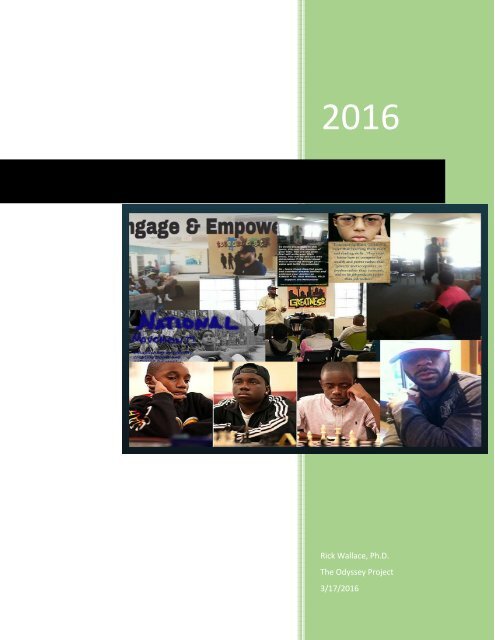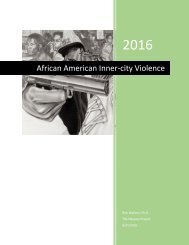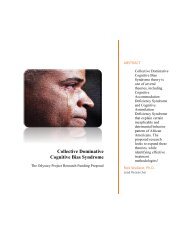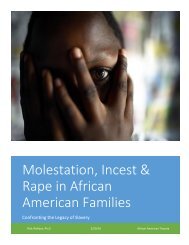Racial Trauma & African Americans
Trauma is a single or repetitive event that overwhelms the nervous system due to a real or perceived threat. When there is a real or perceived threat, we, as humans, organize our functioning for the purpose of responding to the threat. This compendious treatise examines the impact of racial trauma on African Americans.
Trauma is a single or repetitive event that overwhelms the nervous system due to a real or perceived threat. When there is a real or perceived threat, we, as humans, organize our functioning for the purpose of responding to the threat. This compendious treatise examines the impact of racial trauma on African Americans.
You also want an ePaper? Increase the reach of your titles
YUMPU automatically turns print PDFs into web optimized ePapers that Google loves.
2016<br />
Rick Wallace, Ph.D.<br />
The Odyssey Project<br />
3/17/2016
Understanding How <strong>Racial</strong> <strong>Trauma</strong> Impacts <strong>African</strong> <strong>Americans</strong><br />
The Odyssey Project<br />
Research & Advisory Council<br />
March 16, 2016<br />
Rick Wallace, Ph.D.<br />
A substantial amount of my research and studies has been dedicated to understanding the<br />
collective dysfunctionality of <strong>African</strong> <strong>Americans</strong>. I have analyzed and developed theories to<br />
explain the behavior of <strong>African</strong> <strong>Americans</strong> as it pertains to the general inability to effectively<br />
respond to opportunities in life, or to guard against the nefarious and pestilential machinations<br />
that are designed to perpetuate a substandard of existence for them. I have invested much into the<br />
understanding of the influence of cognitive distortions and cognitive biases on the social<br />
mobility and pathological behavior of a large portion of the <strong>African</strong> American community. In<br />
addition to anatomizing the paradigms of Post <strong>Trauma</strong>tic Slave Syndrome, I have developed a<br />
number of theories that rest along the lines of cognitive theory.<br />
The first theory I developed was the Collective Cognitive Bias Reality Syndrome theory, which<br />
is a theory that seeks to explain the manner in which cognitive distortions influence how blacks<br />
think, process stimuli, form habits and behave — through a systematic process of deviated<br />
rationalization — serving to create a reality that is oppugnant to the one they seek. Subsequently,<br />
I developed the Collective Dominative Cognitive Bias theory to explain the dominance of the<br />
influence distorted cognitions in governing the entire existence of a significant number of<br />
<strong>African</strong> <strong>Americans</strong>. Most recently, I developed the Cognitive Assimilation Deficiency theory<br />
and the Cognitive Accommodation Deficiency theories to explain the inability of <strong>African</strong><br />
<strong>Americans</strong> to successfully engage neoteric stimuli that they perceive to be a threat.<br />
What I have discovered during the process of my work is that there is a common denominator<br />
that cannot be ignored. That common denominator is trauma. The birth of three new branches of<br />
science has led to a recent explosion of knowledge about how the effects of psychological<br />
trauma impact humans. These new schools of scientific study are neuroscience, the study of how<br />
the brain supports mental processes; developmental psychopathology, the study of the impact of<br />
adverse experiences on the development of mind and brain; and interpersonal neurobiology, the<br />
study of how our behavior influences the emotions, biology, and mind-sets of those around us<br />
(Kolk, 2014).<br />
What we now know is that trauma, regardless of type or origin, compromises the brain area that<br />
communicates the natural physical, embodied feeling of being alive. These changes in the brain<br />
explain why traumatized individuals become hypervigilant in perceiving threats at the expense of<br />
being able to live their lives in a spontaneous manner. These changes also help us understand<br />
why traumatized people so often keep repeating the same problems and why they have such<br />
trouble learning from experience. What was once believed to be the results of moral failings,
signs of the lack of willpower, or bad character, is actually due to the changes in the brain caused<br />
by traumatic experiences (Kolk, 2014).<br />
The principle aim of psychology is to develop an understanding of the individual variation in the<br />
functioning of humans through the use of broad hypotheses, theories and research that is capable<br />
of not only explaining the variations in human behavior, but creating the mechanisms and<br />
instruments through which we can predict poor behavior in order to intervene in a manner that<br />
palliates or even reverses the behavior.<br />
While the average person will view variation in human behavior as coincidence or an abstract<br />
anomaly, the psychologist, and the inherent analytical thinker, always believes that there is<br />
discoverable and measurable explanation for every occurrence. While we may not always be able<br />
to readily identify the origin of the behavior, we understand that causality is discoverable.<br />
When it comes to the counterproductive and antisocial behavior of <strong>African</strong> <strong>Americans</strong>, it has<br />
been the common practice to study it as a pathological behavior. In other words, it has most<br />
commonly been examined under the model of psychopathology; however, I have discovered that<br />
while pathology must be investigated when studying and developing treatments for antisocial<br />
behavior, the trauma model, which does not place an emphasis on pathology, is able to explain<br />
both, poor and palmary responses to stressful and traumatic events. Additionally, the trauma<br />
model also offers suggestions about the best methods of intervention to efficaciously address and<br />
improve functionality after a traumatic event. More importantly, the vast majority of these<br />
intervention models are cost-effective and non-stigmatizing.<br />
Understanding the <strong>Trauma</strong> Model<br />
<strong>Trauma</strong> is a single or repetitive event that overwhelms the nervous system due to a real or<br />
perceived threat. When there is a real or perceived threat, we, as humans, organize our<br />
functioning for the purpose of responding to the threat.<br />
For those who may be wondering why a perceived threat could cause damage, and compromise<br />
the brain, it is because our nervous system does not do a very good job of distinguishing between<br />
a real or perceived threat. Additionally, what is considered dangerous is not universal among<br />
humans. Experience and the ability to reason can play an immense role in determining how a<br />
person perceives a particular situation. For instance, in the same home, a parent raising a fist at a<br />
three-year- old will likely incite fear, which can lead to a traumatic experience. Conversely, the<br />
same parent raising their fist at their eight-year-old sibling will be responded to differently,<br />
because the older siblings experience, and ability to process what is happening, allows them to<br />
ascertain that the parent is simply gesturing in a playful manner.<br />
The fact that perception frames the idea of what is dangerous, means past experiences play an<br />
important role in determining how people interpret a situation in order to determine if a situation<br />
or experience is dangerous. For instance, a man who, as a boy, was traumatized by domestic<br />
violence that was characterized by loud shouting matches between his parents, may tend to<br />
become anxious and agitated when amongst a room full of excited, and elated football fans.<br />
Although the situation is not hostile, the association of loud raised voices and excitement with
violence, this man experiences a physiological effect. This same man, when in the midst of a<br />
boisterous crowd, now holds his seven-year-old son’s hand anxiously, now the boy becomes<br />
nervous in crowds. This simple example not only illustrates the role of perception in determining<br />
what is dangerous, but it also illustrates how we can literally learn what is dangerous through<br />
relationships, in addition to direct experience.<br />
How does trauma impact human behavior? When there is an assumed threat, living organisms<br />
will respond one of four basic ways: emotional withdrawal, physical distance, by freezing and<br />
aggression. In instances where large groups of people are experiencing danger simultaneously,<br />
the entire range of responses can be observed. These variations in threat-response can be<br />
observed during any type of perceived threat among groups. There is no response to threats that<br />
can be considered universally better than the rest. The best response is determined by the<br />
situation and its underlying influence. The most optimal functioning is experienced when<br />
humans are able to use any of these responses in the appropriate situation at the appropriate time.<br />
<strong>Trauma</strong> occurs in two primary phases. The first phase is the arousal phase, which in where our<br />
nervous system revs up for the purpose of efficaciously responding to the threat. During this<br />
initial phase, our sense of time will become narrowed — losing our sense of the future — being<br />
completely focused on the moment at hand. Next, we lose our capacity for empathy, becoming<br />
more self-consumed, transitioning to primitive responses, such as fight-or-flight. Additionally,<br />
we will rapidly scan our immediate environment to detect any additional threats. We will also<br />
naturally gravitate to people who are similar to us, while becoming increasingly suspicious of<br />
those we consider to be different. People who are highly functional, will be able to determine the<br />
most appropriate course of action despite being emotionally aroused by a traumatic experience<br />
— creatively creating or inventing new responses to the perceived threat, and they have the<br />
capacity to immediately self-correct when the initial response is not proving efficacious.<br />
The recovery phase of trauma is the period in which we begin to develop coping mechanisms to<br />
assist us in processing the experience. The most functional individuals will actually learn from<br />
their traumatic experience, developing an elevated sense of confidence and preparedness for<br />
future situations that are similar in nature. They will be able to function at a higher level than<br />
they did prior to the trauma.<br />
Poor recovery from a traumatic experience can manifest itself in a number of different ways;<br />
however, the most common response is constant hypervigilance, a response in which the person<br />
lives their lives as if their traumatic event is perpetual. The person who responds to trauma in a<br />
non-efficacious manner will remain sensitive and vigilant, constantly looking out for dangers.<br />
They will generally have exaggerated responses to minimal or non-existent threats. There will go<br />
to great lengths to avoid encounters with people or situations that have the capacity to trigger reexperiencing<br />
the threat, or they will become numb to real and perceived threats, failing to<br />
accurately perceive dangers. One way that some individuals are able to remain numb is that they<br />
continue to create dangerous situations that serve to further desensitize them to the presence of<br />
danger.
Generally, the level at which an individual is able to recover from trauma will determine how<br />
well they will be able to function in the future. The manner in which we respond to trauma will<br />
have a massive impact on how well we are able to deal with future stresses in life.<br />
One of the most effective indicators of the likelihood of a person successfully recovering from<br />
trauma is the presence of high-quality relationships that help them develop the coping skills that<br />
will be vital to their recovery and future responses to threats — real or perceived.<br />
Racism Perceived as Danger and <strong>Trauma</strong><br />
It is not uncommon for large-scale catastrophic, traumatic events to impact large groups, even<br />
thousands or millions, as a normal course of human existence. These aeschylean events can<br />
range from terrorist incidents, war, earthquakes, hurricanes and social upheavals.<br />
The type of trauma that I focus on primarily is trauma that is the result of racial and social biases<br />
that serve to negatively impact opportunity, safety and peace of mind for <strong>African</strong> <strong>Americans</strong>. I<br />
view racial trauma in several distinct ways. First, I study intergenerational trauma that has been<br />
passed down from generation to generation, being inextricably bound to slavery. Because freed<br />
slaves were never treated for their trauma, they passed on their trauma to their progeny in a<br />
number of ways, including biological, psychological, and philosophical transmission (Lev-<br />
Wiesel, 2007; Danieli, 1998; Kellermann, 2001).<br />
The next form of trauma that I am concerned with is domestic and environmental trauma, such as<br />
child-molestation, physical abuse, or witnessing violence. While this is not directly associated<br />
with racial bias, it definitely impacts how racial trauma is perceived and engaged. Finally, I also<br />
look at the contemporary racial trauma, which is characterized by racially, culturally or<br />
socioeconomically-motivated antagonistic behavior from people outside of the cultural periphery<br />
of <strong>African</strong> <strong>Americans</strong>, specifically whites.<br />
Like other forms of trauma, <strong>African</strong> <strong>Americans</strong> experience trauma and danger that can be<br />
directly related to race, and these events overwhelm the nervous system. These dangers may be<br />
real or perceived discriminatory acts, threats, police incidents, harm and injury and shaming and<br />
humiliating events. These types of events tend to stand out in the memory of <strong>African</strong> <strong>Americans</strong>,<br />
producing long-term negative effects how we perceive our social environments and ourselves.<br />
Just as with the general population, there are some <strong>African</strong> <strong>Americans</strong> who are stronger and deal<br />
with trauma more effectively than others. The problem is that a substantial number of <strong>African</strong><br />
<strong>Americans</strong> are living at or below the poverty line, meaning that this particular socioeconomic<br />
group is less likely to be prepared to successfully respond to racial trauma.<br />
The second manner in which <strong>African</strong> <strong>Americans</strong> are damaged due to racial trauma is through<br />
witnessing harm and injury to another <strong>African</strong> American. This type of trauma is widely<br />
recognized in the child abuse treatment field of psychology. Children and adults who witness<br />
child abuse, or come in contact with a child abuse victim, will also suffer trauma.<br />
One of the most prevalent ways that <strong>African</strong> <strong>Americans</strong> experience trauma is by living in<br />
difficult social conditions that are directly related to race and poverty, resulting in traumatic<br />
events that occur as a result of these conditions. Segregation, based on class and race is very
common in the U.S. While federal law prohibits discrimination, including segregation, based on<br />
race, this does not protect <strong>African</strong> <strong>Americans</strong> from being isolated based on their inability to<br />
afford inclusion. The communities in which <strong>African</strong> <strong>Americans</strong> live are generally aggressively<br />
policed, socially isolated, have less access to resources for daily living and have high levels of<br />
exposure to alcohol, drugs and guns.<br />
As with any group, the recovery from trauma will vary, depending on how well-prepared each<br />
person is.<br />
Conclusion<br />
There is a wealth of qualitative and quantitative data that suggests that the elevated rate of social<br />
and health problems for groups of <strong>African</strong> <strong>Americans</strong> may, at least partially, be explained<br />
through the use of the trauma model. One reason that I favor this model as a guide in<br />
understanding black behavior is that it is not a deficit model, meaning that it will carry less<br />
stigma, and it will create better opportunities for professionals to work with individuals and<br />
groups. The trauma model proposes that <strong>African</strong> <strong>Americans</strong> can recover from trauma through<br />
effective interventions that are designed to improve coping skills, while decreasing and avoiding<br />
re-experiencing the trauma. Fortunately, these types of coping skills can be taught to <strong>African</strong><br />
<strong>Americans</strong> through a wide range of community-based programs, such as support centers, mental<br />
health centers, schools and churches.<br />
While there is still a substantial amount of work to be done, there is reason to be optimistic when<br />
it comes to creating change.<br />
By<br />
Dr. Rick Wallace, Ph.D.<br />
Other Resources by Dr. Rick Wallace include:<br />
The Mis-education of Black Youth in America<br />
The Invisible Father: Reversing the Curse of a Fatherless Generation<br />
When Your House is Not a Home<br />
Renewing Your Mind<br />
Visit The Odyssey Project Site Here<br />
The Blueprint 1.0
Bibliography<br />
Danieli, V. (1998). Minority Students in Gifted and Special Education Programs: The Case for<br />
Educational Equity. The Journal of Sepcial Education, 41-43.<br />
Kellermann, N. P. (2001). Transmission of Holocaust <strong>Trauma</strong> - An Integrative View. Israel<br />
Journal of Psychiatry, 256-267.<br />
Kolk, B. V. (2014). The Body Keeps the Score. New York: Penguin Publishers.<br />
Lev-Wiesel, R. (2007). Intergenerational Transmission of <strong>Trauma</strong> Across Three Generations: A<br />
Preliminary Study. Qualitative Social Work.

















